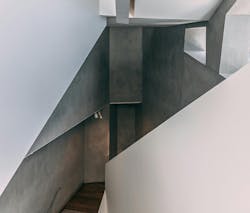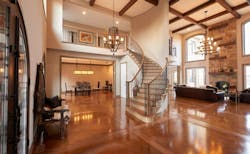Trend Alert: 5 Places to Install a Decorative Concrete Floor
Sure, a concrete floor is typical for a basement or garage, but demand is growing for the use of this versatile, low-maintenance flooring material in other rooms of the home. Stained concrete, in particular, is gaining prominence in both traditional and modern home designs, and is cited by experts as an up-and-coming flooring option.
More architects are embracing this trend, as well, designing slab-on-grade homes with exposed concrete, rather than hiding it under tile, wood, or carpeting. If you’ve been avoiding concrete floors because you think they look too cold and industrial, see how other home builders are using concrete in first-floor living spaces without compromising style.
1. Foyers
Talk about a grand entrance! Many home builders are making a good first impression by using decorative concrete floors in foyers, and personalizing them to reflect the home’s overall style, from elegant to informal.
Enhancements include stenciled motifs, multicolor patterns mimicking tile, unique saw cut designs, and even “floating” concrete islands in shallow pools of water. Aside from their visual impact, concrete floors are ideal for foyers because they are low-maintenance, and can handle heavy foot traffic.
2. Bathrooms
Not only are concrete floors practical and easy to clean, with no grout joints where mold and mildew can grow, but they also allow unlimited design options. They can be stenciled, refinished, or stained to mimic marble flooring. One can also add integral pigments to make the concrete look like as white as porcelain, or as black as granite.
3. Kitchens
Concrete can withstand all the wear and tear common to kitchen floors, including steady traffic, missiles of dropped cutlery, and food and drink spills. Applying a sealant can make it completely waterproof, protecting against stains and moisture that can happen in a home’s nerve center.
4. Great rooms
Another benefit of concrete floors is how well they can brighten a large living space with greater light reflectivity than other flooring options. Installing light-colored, polished concrete floors in high-ceilinged rooms can save energy by amplifying natural light during the day, and reducing the need for artificial light at night.
5. Transitional areas
The boundary between the indoors and outdoors is quickly vanishing, as more interior designers make transitional space seamless. Concrete is one of the few materials that can be used for both indoor and outdoor slabs, making it a great choice for patios that flow into interior rooms.
Natural concrete possesses a unique beauty that’s organic and timeless, its neutral gray color blending well with most materials and color schemes. Don’t be afraid to take a “less is more” approach to your projects by embracing the allure of natural concrete.
About the Author

Anne Balogh
For nearly 20 years, Anne Balogh has been a contributing author for ConcreteNetwork.com, a top online resource for the decorative concrete industry. With a background in concrete construction journalism, Anne shares valuable tips for creating incredible decorative concrete work.

